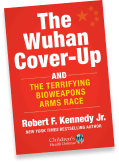Endocrine Disruptors Galore: How Plastic Food Packaging May Be Wreaking Havoc on Your Health
Norwegian researchers reported that chemicals leaching from plastic food packaging may cause more concerning and widespread harm to health than previously realized, including developmental problems and hormone-related cancers.
Miss a day, miss a lot. Subscribe to The Defender's Top News of the Day. It's free.
Endocrine-disrupting chemicals used in plastic food packaging may cause more concerning and widespread harm to health than previously realized, according to a new study in Ecotoxicology and Public Health.
Researchers led by Martin Wagner, Ph.D., a biologist at the Norwegian University of Science and Technology, reported that dozens of packaging plastics and related ingredients leach into foods with unpredictable short- and long-term adverse health effects.
Wagner and co-workers collected 36 plastic food storage containers and plastic-packaged foods from retailers in the U.S., United Kingdom, South Korea, Germany and Norway.
Samples included representatives of the seven most-consumed plastics worldwide: high- and low-density polyethylene (HDPE, LDPE), polyethylene terephthalate (PET), polypropylene (PP), polystyrene (PS), polyurethane (PUR) and polyvinyl chloride (PVC).
Countries were mostly selected for their high plastic consumption and per-capita waste. Norway was chosen for “local interest.”
The sample plastic items included single-use cups, film wraps, trays, reusable storage containers and 17 plastics-packaged foods. Items containing food were emptied, washed and analyzed. Empty containers were analyzed as is.
Researchers assumed packaging items with markers identifying the plastic component were labeled correctly. Where this information was unavailable or unclear, the materials in the items were identified using standard chemical analysis.
Complex materials, complex analysis
Plastics are complex materials consisting of polymers — by far the main component — and many other low-abundance but potentially toxic ingredients added to enhance the plastics’ performance.
BPA (bisphenol A), for example, is added to polycarbonate plastics to create smooth, hard and product-resistant surfaces, while phthalates are added to PVC to reduce PVC’s brittleness and improve its crack resistance.
Humans are exposed when these chemical ingredients leach out of plastics into foods — a process that depends on many factors, such as the food’s chemical composition, how long the food was stored, and under what temperature and conditions.
Because this process takes time and is unpredictable, investigators accelerated it by using a solvent to extract as many chemical components as were available.
Extraction is the use of a solvent to remove one or more components from a substance. Washing clothes is an extraction in which the solvent (water plus detergent) removes components (dirt, oil, stains) from a substance (clothing).
The researchers chose methanol — methyl or “wood” alcohol — because it dissolves many known chemicals in plastics but does not degrade the polymer.
To eliminate extraneous plastic component contamination, all materials used in the extraction process — for example, beakers and spatulas — were made of glass or stainless steel and cleaned before use. Packages that previously contained food were rinsed and dried.
Investigators took 13.5-gram pieces of each packaging material, chopped them up, and extracted them with methanol for two hours or more.
To see if food contents affected which chemicals leached out, investigators tested three items containing store-packaged food versus the same package (obtained from the same vendor) not containing food.
Investigators took samples from each methanol extraction and conducted a chemical analysis to determine which plastic ingredients were present. They also conducted biochemical testing to determine the potential effects on the human endocrine system.
Thousands of ‘chemical features’
Because plastics are so complex and contain so many chemicals, and since the analysis method used by the researchers generated even more unique species, investigators analyzed for both the number of unique chemicals present in every sample, plus “chemical features.”
Although the researchers used the term “chemical features” 37 times in their paper, they did not define the term, nor is it standard organic chemistry jargon. The term is assumed to include the presence of a chemical, its concentration, plus its breakdown products, its concentrations and the presence or absence of other chemicals or features.
On that basis, the researchers detected 2,146 unique chemicals and 25,511 features — 16,846 in the seven PUR and PVC samples, and 8,665 in the 29 PE, PET, PP and PS samples.
The number of features differed among plastic food packaging products, however, with as few as 37 features in an HDPE container and as many as 9,936 in cling wrap.
Unsurprisingly, plastics that required the addition of more chemicals during their manufacture had more identifiable chemical components and more chemical features. Among the plastics studied, HDPE had the fewest features (616) followed by PET (1,320), PS (2,284), PP (2,711), LDPE (5,495), PVC (12,683) and PUR (13,004).
Off-the-charts endocrine receptor activity
The presence of scores or hundreds of chemicals in a product does not necessarily suggest health risks. Apple aroma, for example, contains at least 300 unique compounds whose levels vary widely according to the strain and storage conditions.
After mapping out the extracts’ chemical compositions researchers looked for activity against four endocrine systems of interest to human health: pregnane X receptor (PXR), which helps the body eliminate toxins; peroxisome proliferator-activated receptor γ (PPARγ), which is involved in blood glucose control; estrogen receptor α (ERα), which assists in blood vessel dilation and repair; and the androgen receptor (AR), which is involved in many bodily processes involving testosterone, the male sex hormone.
Extractions from 33 of the 36 plastic objects sampled interfered with at least one receptor.
The leading receptor target was PXR, which was affected by 33 extracts and solely by eight. This was not surprising given the large number of roles this receptor plays in cellular detoxification and its ability to associate with a wide range of biomolecules.
PXR also is involved in maintaining the body’s energy balance and inflammation. Since pharmaceuticals interfering with PXR have been associated with hypercholesterolemia (high cholesterol and heart disease), it’s reasonable to assume plastics can do the same.
PXR effects also rose as the number of chemical features grew, leading the researchers to conclude that screening for PXR activity “provides a good initial representation of the general toxicity as well as the chemical complexity of mixtures of plastic chemicals.”
Twenty-three extracts affected PPARγ, the second-leading target, with the strongest activation from LDPE and PVC extracts. PPARγ is the master regulator of adipogenesis — the formation and accumulation of fat cells — and its activation has been implicated in obesity and metabolic disorders.
Eighteen extracts activated the estrogen receptor, with the strongest effects coming from PS (polystyrene) samples and containers of frozen blueberries and yogurt.
The researchers did not say why these foods brought out the worst in their packaging, but their acidity might promote the extraction of estrogen activators.
Estrogen effects result in developmental and reproductive issues and a higher risk for hormone-related cancers such as breast and prostate cancers.
The researchers also detected “significant” androgen-blocking effects in 14 extracts with the highest effects from LDPE, PVC and PUR and no effects from PET and PP articles. Blocking androgens is associated with numerous reproductive issues in men and women, some of which may be passed from one generation to the next.
One of the study’s takeaways was that plastic materials are complex and consist of many more chemicals than one might suspect from their ingredients or chemical formulas.
This means that health effect studies that examine individual toxins like BPA, or even entire health-related classes like “endocrine disruptors,” may miss the full extent of harm from plastics.
By analyzing finished products instead of specific chemicals, the researchers’ approach captures the entire range of toxins in plastic, including those previously or still unknown.
Sign up for free news and updates from Children’s Health Defense. CHD focuses on legal strategies to defend the health of our children and obtain justice for those injured. We can't do it without your support.







No comments:
Post a Comment